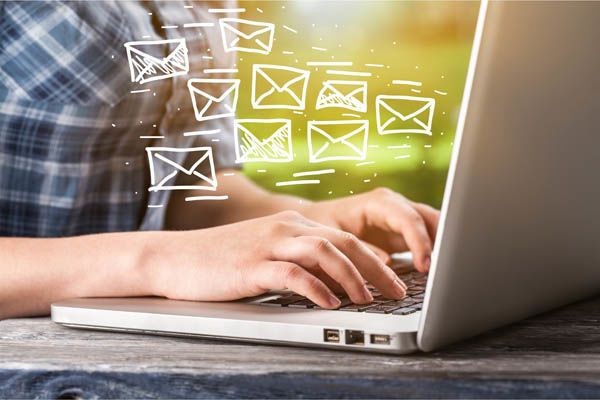Email might be a crucial tool for communication in your day-to-day work, but it can end up being a major waste of time if not used effectively. While having zero unread messages might give you short-term satisfaction, keep in mind that it does not reflect your productivity! You’ll be dragged into a never-ending cycle of distraction, as new emails will only keep coming in.
Here are some tips for checking your emails and minimizing distraction:
1. The 24-hour method
Other people argue that rather than check your emails starting later in the day, you should just check them once per day, in the morning. Among the members of this camp is productivity expert Elizabeth Grace Saunders. She generally clears out her inbox during the first 1-2 hours of her day and formulates her game plan for the rest of the day after that. After that, she doesn’t generally look at her email again for the rest of the day, allowing her to focus completely on business development and client projects.
This is harder, of course, if you are at the bottom of the food chain at your company. But if you are in upper management or you are self-employed, setting this routine can be a great way to boost your productivity.
2. When in doubt, check the chart
You can check your email twice a day and use a handy flow chart for helping you to blow through all the unread messages in your inbox.
Every time you open a new email, ask yourself 3 basic questions:
- Is this relevant?
- Can I solve this?
- Will it take less than 2 minutes of my time to deal with this?
By following this handy flow chart, you’ll develop a new way to bust through your inbox more efficiently.
3. 5 a day
And just in case you hadn’t had enough conflicting expert opinions, here’s one more. Rod Kurtz of Business Week argues that you ought to be checking your work email five times per day.
“Check your inbox only five times daily–first thing in the morning, mid-morning, after lunch, mid-afternoon, and end of the day. Or even less if you are capable. This works when you turn off the automatic send/receive function, allowing you up to two hours to focus on your work, rather than to be continually interrupted. It works when you group the sorting of your e-mail, making you more productive and efficient in dealing with it.”
4. Don’t check your email first thing in the morning
Imagine coming in to work with urgent tasks to finish by the end of the day, only to open your inbox and find hundreds of unread emails. Hours later, you finish responding to the emails only to realize that your day is gone!
It’s an instinctive habit for many professionals to check their inbox the moment they reach the office, or even worse, as soon as they wake up in the morning. While you might think that checking your emails before moving on to other tasks boosts your productivity, it’s one of the worst ways to start your day.
If you are worried there could be an urgent exchange lurking in your messages, you can set yourself a timer to skim and respond to only those emails that are time-sensitive. Otherwise, save a deeper look at your incoming messages for later in the morning, once you’ve completed an important item on your to-do list.
5. Don’t check your email when you’re overwhelmed and procrastinating
When you’re feeling overwhelmed with your workload and approaching deadlines, it’s easy to think of checking your email as being productive. Responding to your emails might help you feel like you’re getting something done, but in fact, you’re just running away from reality and putting off tasks that are more urgent and critical.
6. Do use the 2-minute rule to skim through your inbox
If you’re worried that you might be missing out on urgent requests and emails from your boss by not checking your inbox, use the “2-minute” rule to skim through your emails at a set time in the morning.
Look through your inbox and identify emails that require immediate response or ones that can be replied to easily. If you can finish your responses to these emails in two minutes, send them right away. Keep in mind that this doesn’t mean that you should respond to every email that you can respond within two minutes.
This strategy means responding to messages that you can process easily and that relate to important people in the organization. Anything else can wait until later when you have more time.
7. Check your email when you’re away on a business trip
If your employer is sending you away for conferences or business meetings and you’ve disappeared from their email trails without a single response, things won’t look good for you. Remember, while you shouldn’t be expected to be reachable 24/7 while traveling for work, your employer should be able to contact you from time to time during the duration of your trip. The company is bearing the cost of your excursion after all, so that isn’t too much to ask for.
Additionally, you should also be up to date with your emails when traveling on a business trip so that you don’t miss out on what’s going on back at the office.
If you’re traveling, always make sure that you enable roaming data or buy a local SIM card for easier connectivity.
8. Check your email when you’re expecting an important response
If you’re waiting for an important email from your clients, a delayed response can significantly slow down the progress of the whole project and opens up room for miscommunication and misinterpretation. Hence, keep your inbox open when you’re expecting important emails. It also helps to set up special notifications on your phone for certain senders so that you’ll get alerts when they email you. Setting up alerts like these would help to prevent distractions from unnecessary promotional messages.
9. Check your email when you’re commuting on public transportation
If you happen to take the train or bus to work daily, this would be an ideal place to skim through your inbox and apply the 2-minute rule. It gives you a productive start to the day, using time that can’t be spent doing much else. Additionally, it helps you to dive straight into urgent tasks when you reach the office. Similarly, the evening commute back home can be used to organize your emails into folders, delete spam and promotional messages, and set up an action list for the next day.
10. Check your email at a scheduled time
Some situations and times call for email checking—and other times when you should ‘X’ out of the window or app and force yourself to be head down.
One of the most efficient ways to boost productivity is to schedule tasks in your calendar and keep to it. Similar to how you block out time for meetings and events in your calendar, set aside a block of time every day to check and respond to your emails. Setting aside a specific time like this helps to keep yourself accountable and fully focus on the task at hand. Additionally, this habit helps to set clear expectations for your colleagues about your response time.
In conclusion, don’t let your inbox rule your time and energy. Instead, follow these tips to create an efficient and effective way of checking and responding to your work emails each day. If you approach your email with the correct attitude, you can boost your productivity by leaps and bounds.

